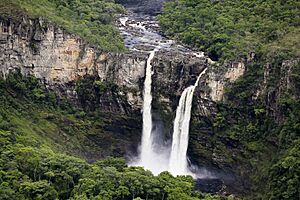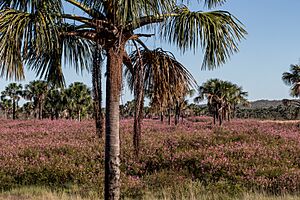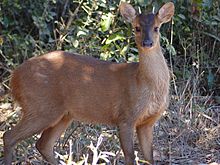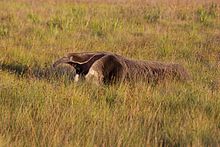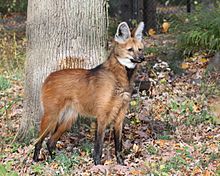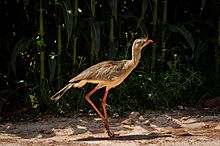Cerrado facts for kids
Quick facts for kids Cerrado |
|
|---|---|
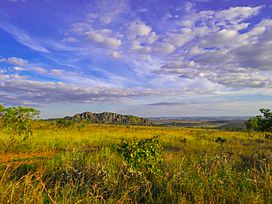
Vegetation in Pirineus State Park, Goiás
|
|
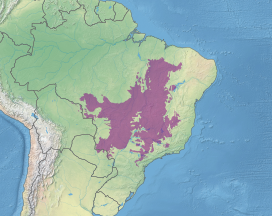
Map of the Cerrado ecoregion as delineated by the World Wide Fund for Nature.
|
|
| Ecology | |
| Realm | Neotropical |
| Biome | tropical and subtropical grasslands, savannas, and shrublands |
| Borders |
List
|
| Geography | |
| Area | 1,910,037 km2 (737,469 sq mi) |
| Countries | Brazil, Bolivia and Paraguay |
| Conservation | |
| Conservation status | Vulnerable |
| Global 200 | Cerrado woodlands and savannas |
| Protected | 433,581 km² (23%) |
The Cerrado (Portuguese pronunciation: [seˈʁadu]) is a huge area of tropical savanna in eastern Brazil. You can find it in states like Goiás, Mato Grosso do Sul, Mato Grosso, Tocantins, Maranhão, Piauí, Bahia, Minas Gerais, São Paulo, Paraná, and the Federal District. The main part of the Cerrado is in the Brazilian highlands.
This amazing place has different types of habitats. These include forest savanna, wooded savanna, and grassy savannas with some trees. The Cerrado also has wetlands and gallery forests (forests along rivers).
It is the second largest of Brazil's major habitat types, right after the Amazon rainforest. The Cerrado covers about 21% of Brazil's land. It even stretches a little into Paraguay and Bolivia. About 75% of the Cerrado's land is privately owned. This makes protecting it a bit tricky.
Scientists have found that the Cerrado is one of the richest tropical savanna regions. It has many unique plants and animals found nowhere else. The World Wide Fund for Nature calls it the most biodiverse savanna in the world. It has about 10,000 plant species and 10 bird species that live only there. Nearly 200 types of mammals live in the Cerrado, with 14 of them being unique to the area.
Contents
What is the Cerrado's climate like?
The Cerrado has a typical wet savanna climate. It has two main seasons: a wet season and a dry season. The average temperature is between 22 and 27 °C. It gets about 80–200 cm of rain each year.
The dry season is very strong during the southern winter, usually from April to September.
What kind of plants grow in the Cerrado?
The Cerrado has very special types of plants. It's like a changing puzzle of habitats. You'll find savanna areas on high, dry ground. Along streams, there are tall, closed forests called gallery forests.
Between the savanna and the gallery forest, there's a wet grassy area. Here, trees don't grow well because the water level changes a lot with the seasons.
The savanna part of the Cerrado has different amounts of tree cover. Scientists have divided it into four types:
- campo sujo: mostly grass with a few small trees (about 3 meters tall).
- campo cerrado: a bit more trees, about 4 meters tall on average.
- cerrado sensu stricto: looks like an orchard with trees about 6 meters high.
- cerradão: almost half covered by trees, usually about 9 meters tall.
Around 800 different tree species grow in the Cerrado. Many plants in the Cerrado are good at surviving fires. They have thick, corky bark that protects them from heat.
Scientists believe the Cerrado's plants are very old. They might have started growing even before Africa and South America split apart. The Cerrado and the Amazon rainforest have probably grown and shrunk over time. This has helped create the many different species we see today.
What animals live in the Cerrado?
The Cerrado is home to many different animals. It has 150 types of amphibians, 120 reptile species, 837 bird species, and 161 mammal species.
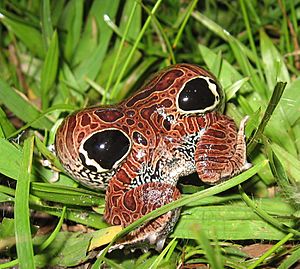
You can find many kinds of lizards in the Cerrado. The Ameiva ameiva is one of the largest lizards here. There are also many snakes, especially in the open areas. Not much is known about the amphibians, but they are likely unique to this region.
Most birds in the Cerrado live and breed there. Some birds fly through during their migrations. Many Cerrado birds are related to those in the Atlantic and Amazon rainforests. Famous birds include the crowned solitary eagle, hyacinth macaw, and toco toucan.
Gallery forests are important homes for most mammals. These areas have more water and are safe from fires. Some famous mammals include the Brazilian tapir and Pampas deer. Large predators like the maned wolf, cougar, and jaguar also live here. You can also find several types of monkeys, like the black-striped capuchin.
Insects in the Cerrado are still being studied. Leaf cutter ants are very common here. They help break down dead plants and are food for other animals. The Cerrado also has the most types of galling insects in the world. These insects make special growths on plants.
Who lives in the Cerrado?
The first detailed description of the Cerrado by a European was from Danish botanist Eugenius Warming in 1892.
Long ago, the people living in the Cerrado learned to use fire. They would burn parts of the land to help new grass grow. This provided more food for their animals.
Many different indigenous groups lived in the Cerrado. These included the Xavantes, Karajás, and Krahôs. Many of these groups were nomads, meaning they moved around. They hunted animals and gathered plants. Others practiced a type of farming called coivara, which involved clearing land by burning.
Over time, different groups of people came to live in the Cerrado. These included indigenous people, quilombola communities (descendants of runaway slaves), and people who gathered resources from the land. All these groups relied heavily on the Cerrado's natural resources.
Until the 1960s, farming in the Cerrado was small. The soil wasn't very fertile for growing crops. People mostly raised cattle for food for local markets. But after that, cities and industries grew in Brazil. This pushed farming into the Cerrado region.
The capital of Brazil moved to Brasília, which also brought more people to the central region. From 1975 to the early 1980s, the government started programs to help farming grow in the Cerrado. This led to a big increase in farming and cattle raising.
However, more people and more farming have hurt the Cerrado's amazing biodiversity. The population in the Cerrado more than doubled from 1970 to 2010.
How is the Cerrado used for farming?
For a long time, people thought the Cerrado was too hard to farm. But researchers in Brazil found a way to make the soil good for crops. They added phosphorus and lime to the soil. This helped industrial farming grow very fast in the area.
Researchers also created types of soybeans that could grow in tropical climates. Before, soybeans were a crop for cooler areas. Today, Brazil is a top soybean exporter. This is because there's a huge demand for animal feed around the world.
Now, the Cerrado produces over 70% of Brazil's beef cattle. It's also a major center for growing grains like soybeans, beans, corn, and rice. Large parts of the Cerrado are also used to grow trees like eucalyptus and pines for paper. Coffee from the Cerrado is also a big export.
Charcoal production
Making charcoal for Brazil's steel industry is another big activity in the Cerrado. It's connected to farming. When land is cleared for new farms, the tree trunks and roots are often used to make charcoal. This helps people earn money from clearing the land.
The Brazilian steel industry has always used wood from the Cerrado for charcoal. But now, with very large steel mills, it's taking a much bigger toll on the Cerrado. However, efforts are growing to use charcoal from eucalyptus tree farms instead.
What about the rivers in the Cerrado?
The Cerrado biome is very important for Brazil's water. It's where many major South American rivers begin. These include the Paraná-Paraguay, Araguaia-Tocantins, and São Francisco river basins. It also feeds large rivers that flow into the Amazon.
Over the last 40 years, the Cerrado's rivers have been greatly affected. This is due to lots of trees being cut down, more farms and cattle ranches, building dams, and taking water for irrigation.
Why is the Cerrado important to protect?
The Cerrado is the second largest biome in South America. It is also the most biodiverse savanna in the world. But it is not officially recognized as a "National Heritage" by the Brazilian Constitution.
It's also home to the Guarani Aquifer, which is a huge underground freshwater reserve. This aquifer provides water to many major rivers.
Some people involved in farming and government don't see the Cerrado as important to protect. Only about 1.5% of the Cerrado is protected in Federal Reserves. By 1994, about 35% of the Cerrado had been changed by human activity. In total, 37.3% of the Cerrado has been completely converted for human use. Another 41.4% is used for cattle grazing and charcoal production. The gallery forests have been hit the hardest. It's thought that only about 21.3% of the original plants remain untouched today.
In the last 25 years, the Cerrado has been threatened more and more. This is due to large-scale farming of single crops, especially soybeans. Also, uncontrolled growth of industrial farming, burning plants for charcoal, and building dams are causing problems for many Brazilian rivers.
This industrial farming has grown a lot because of government help. This includes tax breaks and low-interest loans. This has led to a highly mechanized farming system. Big companies like ADM, Cargill, and Bunge also influence soybean production in the Cerrado. These companies are linked to a lot of the deforestation in this area.
One challenge in protecting the Cerrado is deciding where to put new reserves. The Cerrado has many different types of plants. Scientists are working to find the best areas to protect its unique biodiversity.
Protected areas in the Cerrado
In 2017, it was found that 433,581 km², or 23%, of the Cerrado is in protected areas. Some of these protected areas in Brazil include:
- Chapada das Mesas National Park
- Emas National Park
- Grande Sertão Veredas National Park
- Nascentes do Rio Parnaíba National Park
- Serra do Cipó National Park
- Nascentes Geraizeiras Sustainable Development Reserve
- Cavernas do Peruaçu Environmental Protection Area
- Iquê Ecological Station
- Serra Geral do Tocantins Ecological Station
- Jalapão State Park
- Serra de Santa Bárbara State Park
- Pireneus State Park
- Terra Ronca State Park
You can also find the Noel Kempff Mercado National Park in Bolivia.
See also
 In Spanish: Ecorregión del Cerrado para niños
In Spanish: Ecorregión del Cerrado para niños


